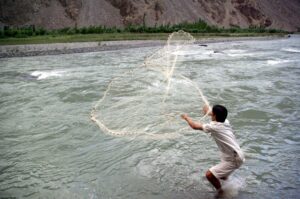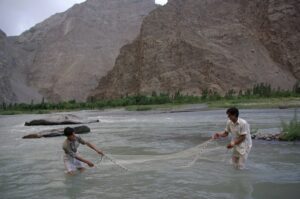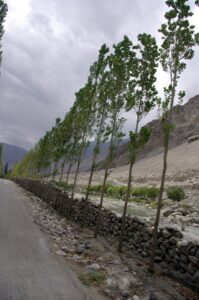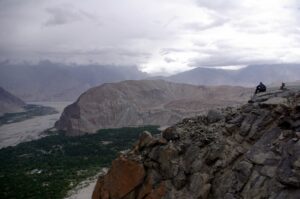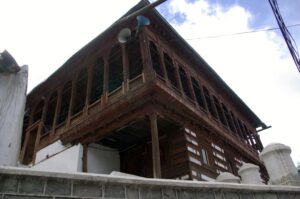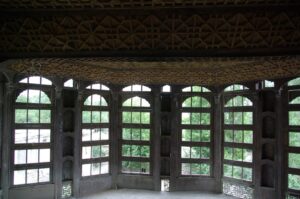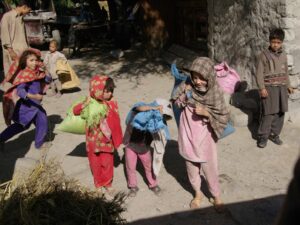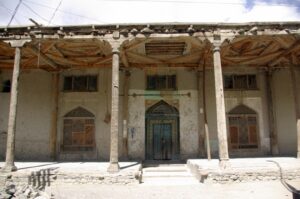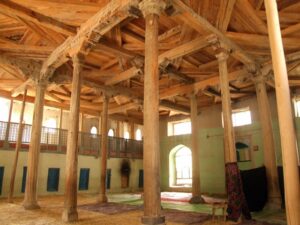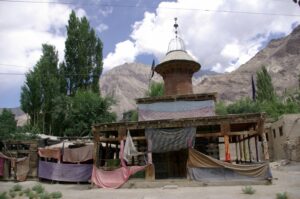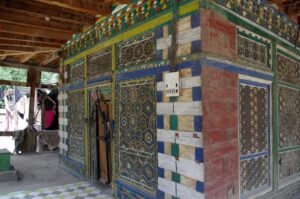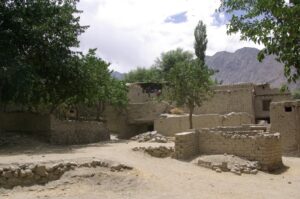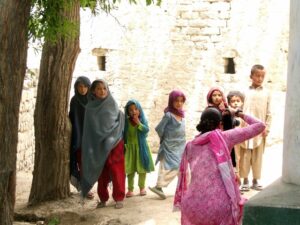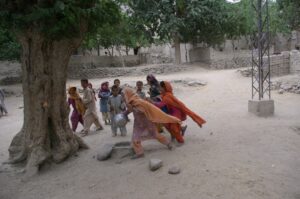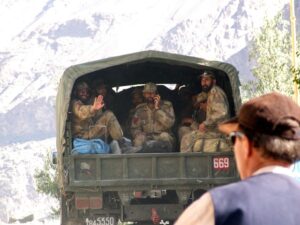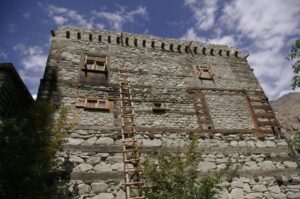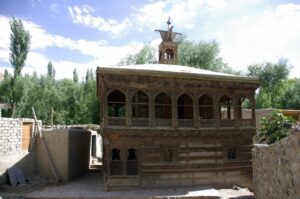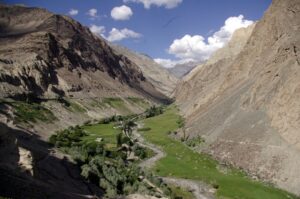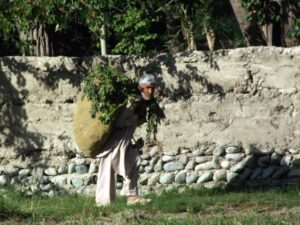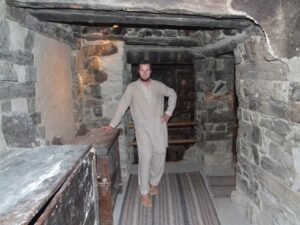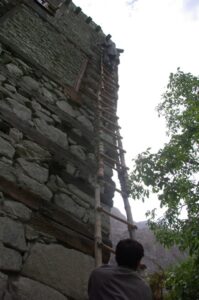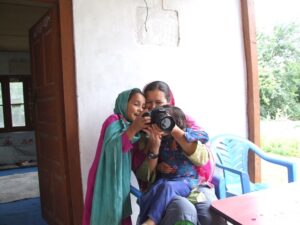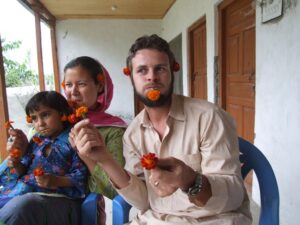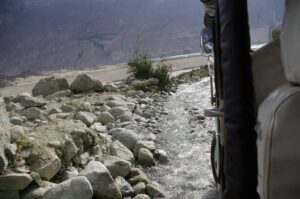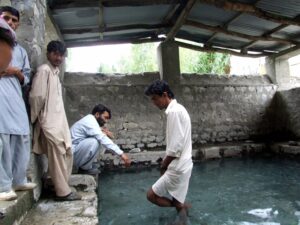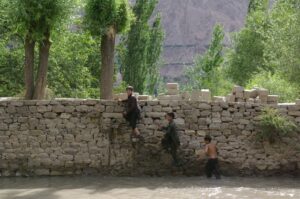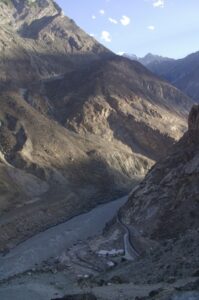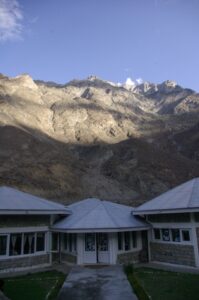Baltistan is a semi-autonomous region in Northern Pakistan ranging from Skardu to K2, principally inhabited by the Balti Shi’a Muslims of Tibetan descent. We spent about a week in this beautiful section of the country, enjoying the incredible scenery and the warm hospitality of friendly villagers. Our tour took us to Skardu (Karpochu Fort, Skardu Buddha and trout fishing at Kachura Lake were highlights), Shigar (splurge for an overnight stay at the Shigar Fort…its lovely), Astak (a visit to the remote Rhondu village was the ultimate highlight of our Pakistan vacation…to meet villagers who haven’t seen a Westerner in over 20 years), Khapulo/Khaplu (see the Khaplu Fort and hike uphill from Chakhchun Village for a breathtaking view of Masherbrum Mountain), Keris (ask a local to show you the old wooden/mud built mosque and try to catch a glimpse of the Keris Fort), Gulab Pur (a homestay at this small village gave us special insight into the daily life of its inhabitants), and Choutron Hot Springs (see if you can stand the heat of these hot springs!).
Hindsight is 20/20. Our original itinerary skipped the Baltistan region, (we had planned to hike up to the annual Boroghil Yak Festival but it was cancelled due to security concerns), but we are glad that we decided to adjust our plans to include this region of Pakistan. Some of the best memories from our trip are from this magical region of the country!
17 Jul 08: After leaving Deosai, we pulled over for a late breakfast at Lake Sadpara, where we ate at the Lake View Motel Sadpara. Becky was impressed with their clean restroom, although the incessant staring from some nearby guests was a bit annoying. It’s a bit disconcerting focusing on enjoying your meal when you are subjected to constant scrutiny and curiosity. We ate in a hurry, and declined Zia’s invitation to hike around the lake. Instead, we opted to check in early to our Skardu hotel, which was the excellent Hotel Mashabrum. It was really hot in Skardu when we arrived around noon. Today, the Skardu locals were celebrating some Eid festival, and the crowded streets of Skardu were strewn with decorations. Our hotel was packed with numerous guests, unlike most of the other hotels we had been to. Apparently, Skardu is the hip and happening place to rest up either before or after embarking on a trek. We learned that Skardu is popular because it holds the Northern Area’s largest airport, and makes a logical choice as base of operations for trekking onward to K2 or beyond. There were lots of trekkers chilling in the hotel lobby, whom we checked out while sipping on our chilled mango juice, waiting to check into our room. We were thrilled to see that we not only had ample electricity, but also lots of hot water! It was laundry time, and we wasted no time in stripping down and scrubbing the grubbiness off ourselves and our clothes.
It was way too hot out to explore the nearby Skardu Fort, so we agreed to wait until it had cooled off considerably. Later that afternoon, Zia interrupted our midafternoon snooze to introduce us to his two cousins, Hasan and Anwar. Hasan is a 23 year old student in accounting and Anwar is a 33 year old Homoeopathist/acupuncturist. We liked both of them instantly, and were happy they decided to join us on our afternoon excursion. It was a steep 20 minute hike to reach Fort Kharphocho, which has excellent views of Skardu. The fort’s gate appeared closed, but we just knocked and the caretaker (who was resting inside) awoke and opened the door for us. From the fort, we could look down upon Skardu’s polo stadium (which hosts several exciting polo matches), and admire the entire Skardu Valley…very nice! Somehow, our afternoon plans to visit a nearby village were thwarted by an impromptu fishing expedition. First it was a sly question of “do you like trout”, followed by a wink and a grin and lo and behold, we had solid plans to drive out to Kachura Lake to catch some fish. However, a quick detour to Anwar’s office was in order, where we were given glasses of grape juice (delicious), followed by a quick heart rate reading. Several coordinating phone calls later, we were given the green light that we could proceed on our way. Kachura Lake is located about 30 minutes outside of Skardu, and we passed by the posh Shangri-La resort on our way to meet the rest of the fishing crew. Patiently waiting nearby the lake was Taki, the son of one of Anwar’s clients. Taki works in Syria, but was on holiday visiting his family. Lucky for us, as his English was excellent, and he proved a most entertaining host. Robby kept looking out for fishing poles so he could help with fishing, but Taki explained that the trout are quite devious and best caught the old fashioned way…with a net. Sure enough, we netted about 15 trout after only one hour’s worth of fishing. The fishing method was quite ingenious….throw a rock upstream and the trout will dash into the net…we watched this technique being used time and time again and were amazed at how it worked.
We fished until it got really dark, and stumbled blindly in the dark back to our jeep. We had been invited to camp by the Lake, but our gear was at the hotel, so we politely declined. Hopefully we will be able to link up with Taki either in Syria or Pakistan one of these days! We exchanged emails and contact information, and bid him and his family farewell. Anwar asked us if we would like to enjoy our freshly caught fish at his house, and despite the late hour, we accepted. Wow, his wife went all out! While we hung out upstairs and relaxed in the large receiving room, Anwar’s wife and brother were busy at work putting together fried trout, chicken karai, rice, na’an, vegetables, and fruit platters. We were treated like royalty, with dishes brought up and displayed before us, before being whisked away and even more food brought out. Despite our entreaties that we were fully stuffed, Anwar urged us to eat more. Jan, who had taken the afternoon off to relax, showed up with our jeep and joined us in the feast, and it was close to midnight before we thanked Anwar and his family for their gracious hospitality. What a day!
18 Jul 08: We checked out of the Hotel Mashabrum after a mediocre buffet breakfast. Our destination for the day was Khapulo/Khaplu, located about 100 km east of Skardu. We read that it was the second largest kingdom in old Baltistan. Zia explained that Baltistan is an area in Northern Pakistan ranging from Skardu to K2, principally inhabited by the Balti Shi’a Muslims of Tibetan descent. We started noticing a lot of Baltistan license plates, and realized the people of this region believe themselves to be largely autonomous. It took us just over 4 hours to reach Khaplu from Skardu and we checked into the Karakoram Lodge Khaplu.
Our agenda for the day was to visit the Khaplu Fort, and hike uphill from Chakhchun Village to see the exterior of an old mosque, and admire the panorama of Masherbrum Mountain. The caretaker for the Khaplu Fort was at Friday prayers, so we agreed to come back later after our hike. Even though the fort was undergoing renovations, it was still evident that it is a magnificent building that will look amazing upon completion. Jan drove us up to Chakhchun Village, where we disembarked and were greeted by noisy (and curious) kids. As soon as they spied our cameras, the girls ran shrieking away, and the boys laughed and put on a show. We quickly lost the kids as we started our steep hike uphill, and after about 20 minutes, reached the old mosque. Apparently, the foundations were laid in the 16th Century when the people first embraced Islam. The views across the valley were absolutely amazing, and well worth the hike uphill…simply stunning. We took a few photos after admiring the view, and then headed back into the village. One of the village men demanded to know if we had entered the mosque. This is a big no go for non Muslims and Zia explained that we had only seen it from the outside and did not enter the mosque. The man was a bit hostile at first but placated when he realized we did not step foot inside the mosque.
The caretaker for the Khaplu Fort had returned when we came back, and he unlocked the door to the fort and led us inside. With a bit of imagination, it is easy to imagine the old royal palace restored to its former glory. The conservation and reuse of Khaplu Palace has been funded by the government of Norway and the Aga Khan Cultural Trust and their work is magnificent. We met the project manager responsible for the renovations of the Shigar Fort (he was now in charge of the Khaplu Palace project) and he happily explained the entire concept to us. Apparently, upon completion of the project, an upscale hotel boutique will be opened for guests to stay overnight. We walked through and saw the individual guest bedrooms, and marveled at the enormous undertaking. We can’t wait to see Khaplu Fort upon completion! Afterwards, we returned back to the Karakoram Lodge and had the rest of the afternoon off. Dinner that night was excellent, consisting of mutton karai and chicken fried rice. Delicious!
19 Jul 08: We were unsure of our departure time this morning, as we were unsuccessful reaching Zia and Jan last night after dinner. However, we assumed that it would be around 0800 or so. We had breakfast at the Karakoram Lodge restaurant and packed up ready to leave by 0800. Still no sign of Zia and Jan. Robby enquired at reception for their room number and we found out they had just arrived for breakfast. At around 0830, we were on the road (Zia and Jan ate fast!). It was a short but picturesque two hour drive from Khaplu to Keris. Our guidebook had virtually no information about Keris. The one mention of it is “On the roadside west of Gol are boulders carved with Buddhist motifs, old script and modern graffiti. Half an hour on, the road crosses the Indus and joins the Shyok [river]. Opposite is Keris, at the mouth of a valley that was once a separate kingdom under a branch of Khaplu’s royal line.”
When we arrived to Keris, Zia called one of his cousins, Jamal, whom he hadn’t seen in over 15 years. Jamal warmly greeted us and escorted us around his small village. The children of Keris were super curious about us, but were also completely freaked out by our cameras at first. So we avoided pointing our lenses at anyone, and focused on the beautiful Keris architecture. The highlight of this small village is an old, massive wooden/mud mosque. We were allowed to enter inside (Becky had to completely cover her hair), and had a large entourage of children following our every move. Afterwards, we visited the holy shrine of the Hazrat Meer Muktar-E-Akhyar. The shrine was kept locked up in a compound, and contained several wooden mosques. Unfortunately, a fire had ravaged some of the mosques, and all that remained were several charred ruins. Thankfully, the main shrine has been kept in impeccable shape, and its distinct colorful hues were extremely eye catching. Lastly, Jamal took us to the Keris Fort, which is currently inhabited by a single family. After seeing the Khaplu Fort’s renovations, it was easy to envision the same being done to the Keris Fort, because much of its original beauty is kept intact even today. With a complete uplift, it would be a stunning building.
Jamal invited us to have lunch at his house, and we readily accepted. When we took a photo of him and his son, the children around us became wide eyed with amazement, and soon we had several boys shyly ask us to take their photo too. They absolutely loved looking at their own image in the digital display, and slowly overcame their fear of being photographed. Lunch was great, with a huge spread laid out before us. Jamal’s family spared no expense, and we kept trying to decline the extra plates of food being brought out. We ate until we were stuffed, and were later invited to meet with the female members of Jamal’s family. This was a first for Robby, who normally was excluded from meeting and interacting with Pakistani females. We posed with Jamal and his entire family, and the women kept beckoning Becky to stay overnight. They were extremely gregarious and friendly, and insistent that we stay. It took all of our willpower to decline, as we still had Shigar as our final destination of the day. We did promise to mail Jamal a copy of the family portrait, and reluctantly said goodbye to his wonderful family.
Jamal asked if he could accompany us to Shigar, to meet the rest of Zia’s family. It had been 15 long years since he last saw them, and we readily agreed. The drive out to Shigar was really cool. Shigar has long been the base of operations for K2 trekkers, and is only about a 1 hour drive away from Skardu. We had lovely views of Shigar valley, which is smack dab in the middle of the Karakoram, Hunza and Rondu mountain ranges. We pulled up to the nicely restored Shigar Fort, and met the intrepid Steve from Australia (he was working in PNG and saved up all his vakay and was now on a 4.5 week tour from Pakistan – China). He joined us for a quick tour of the fort, and we all marveled at what a fantastic job the conservation project had done with Shigar Fort. The government of Norway, in conjunction with Germany, Greece, Spain and American Express had consolidated efforts in the restoration of the ancient fort, which was the former Raja of Shigar’s timber/stone palace. We were so impressed that we decided it would be worth paying a bit extra to spend the night here…imagine sleeping overnight in a palace-cum-museum!
Zia’s father was in Shigar to meet him and Jamal, and since he had connections to the King of Shigar, asked us if we would like for him to make an arrangement to see him? We very much wanted to, but unfortunately the King was away at Skardu for the day, so we agreed to try again later. Instead, we decided, despite the midday sun, to hike up to the old military fort located on the rocks above us. Our guidebook made the hike sound easy, with a description of “for views of the Shigar Valley, walk up Bauma Lungma for 20 minutes and double back up to the thumb of rock above the village”. Yeah right! It was a scary climb/scramble up the rock and Becky was a bit petrified the rock would give way. However, the view was magnificent…still, the safety factor of this expedition leaves much to be considered. There is no real set path, and it requires a lot of scrambling up and down rocks. We parted ways with Steve after our joint hike, and rode out to meet Shigar’s oldest villager. At 106 years old, the village elder appeared to have all his wits and physical prowess about him…amazing. We sat and had tea and apricots and found out the secret to his success was to hunt and eat 400 Ibex, and consume lots of peanut oil and milk! He was a very personable fellow, and we promised to send him a photo of himself when we returned. Apparently a group of French tourists made good on their promise to send him a photo and it still thrills him to this day.
We checked into the Shigar Fort after our day’s explorations, and were thrilled to find it’s a heritage hotel. It’s an excellent little find and we were so glad that Vertical Explorers agreed to foot the bill for one night’s stay. What an experience! (We probably broke our budget as we originally had 3 nights stay in Shigar, but instead we ended up doing a homestay with Zia’s family in Gulab Pur). It was worth the change in plans, as our overnight stay was unforgettable. We both decided to wear our cleanest (and nicest) set of Shalwar Kameez and joined Steve for a dinner buffet of Chinese and Pakistani food. Afterwards, we explored the museum portion of Shigar Fort until our heart’s content, before contentedly falling asleep in our quaint room. Shigar Fort gets two HUGE thumbs up and a hearty endorsement. If you are going to splurge in Pakistan, save it for Shigar Fort…it’s worth an overnight or two.
20 Jul 08: Breakfast at the Shigar Fort was a nice affair, with eggs to order. Zia had arranged for a horseback ride for both of us, and had advised us to have our bags packed and ready for departure at 0830. We were ready to go, but Zia was a no show so we wandered around the garden and decided to take a short snooze on a comfy lounger. At around 0915, Zia showed up and said he had been delayed trying to organize the horses. Apparently, horseback riding in Shigar is not a common activity for tourists, so Zia had to organize polo horses as our rides. Little did we know at the time, but riding the polo horses was going to be a lot more than we had bargained for!
First, we had a quick window of opportunity to meet with the King of Shigar, who lives in a nice house across the street from the Shigar Fort. In 1999, Shigar Fort was bequeathed to the people of Baltistan by Raja Mohammad Ali Sha Saba Amacha and his son, Raja Mohammad Azam Khan of Shigar. Apparently, the Raja didn’t have to move too far away as he now lives about 30 seconds from Shigar Fort. Our meet and greet visit was short, as the Raja had more visitors to entertain, but he did proudly show off a “Jashn e Nauroze 2008 Polo Winner” trophy cup…polo is obviously big business with the Raja funding the Shigar polo team’s expenses. Now it was time for us to mount our horses for a quick ride out towards Gulab Pur, our destination for the day. The horses were quite sturdy in stature, and they were excited to get going. We were lulled into a false sense of security as they calmly trotted downhill. However, once they got to a flat stretch of the road, the horses went wild and broke into an all out sprint. Apparently, polo horses are quite competitive, and Becky’s horse was having none of it in letting Robby’s horse beat him. It was actually quite a scary experience as neither one of us had protective head gear, and if we fell off the horse onto the hard pavement…it was a thought we immediately banished from our minds. It took all our might to pull the reins and force the horses to stop. On the polo field, they are used to “go, go, go”, not “stop, stop, STOP”, and they didn’t like being restrained one bit. Becky swears her horse was the devil incarnate, as he tried his best to buck her off every chance he got. The only time the horses weren’t aggressive was when they had to cross over a wooden bridge. The gap in between the road and the bridge completely psyched them out, and they had to be led across the bridge. Other than that, the horses knew only one speed (super fast) and they tried their best to sprint the entire way to Gulab Pur. After about an hour and a half, we were ready to ride in the jeep which had been trailing us the entire way, carrying our gear. We dismounted and thanked the owners, before wearily climbing into the jeep and relaxing the rest of the trip to Gulab Pur. Riding crazy horses is very hard work!
Gulab Pur is a small village, and the reason why we visited is that Zia’s family lives here. We were invited to spend the night, meet the family, and relax the rest of the day. We were immediately shown to the guest house (separated from the main house where Zia’s rather large family had gathered), and took a quick snooze. After lunch was served, Zia’s nieces (Osmah, Naima) and nephew (Efran) showed up and kept us entertained the rest of the day. Osmah was the most vivacious of the group, and she quickly picked up the art of photography. It was uncanny how she went from having never seen a digital camera before to zooming, focusing and snapping various shots from all sorts of angles. We told Zia that Osmah has a future as a professional photographer as she certainly has a knack for it. The kids decided we needed to make a break for it and mimicked that we should “low crawl” in front of the main house to sneak into Gulab Pur village. We agreed, and broke free from the guest house to meet with the other villagers. Becky’s experience was pretty cool, as she was invited into homes to meet with the other women who tried their best to communicate with her. Broken English and sign language became the best method of communication, and the women were definitely curious about Becky! While walking around the village, Becky noticed our original driver, Hamid, working out in the field. What a shock….we didn’t know he was neighbors with Zia and had felt bad that we didn’t get to see him in Gilgit. Lucky for us and for him, as we were able to give him his long overdue tip for his earlier service to us.
It was mulberry season, and we helped the kids pick baskets worth of mulberries. Osmah clambered up into a tree and started shaking branches. Underneath, we held my scarf out to catch the raining mulberries. Little did we realize the staining power of these tasty fruit, as our fingers were soon dyed dark blue from the oozing juice. More photography sessions ensued (Osmah is really addicted to photography), and Becky was dragged down to the farming field and nearby river by Zia’s youngest sister, who spoke decent English. It was non stop action until the sun set, when the children were finally called off and we had a minute or two to catch our breath. Zia and Jan finally reappeared and joined us for dinner. We had a wonderful spread laid out before us, and exchanged stories about our day. Surprisingly, we had electricity so we decided to download photos to show to Zia and Jan, before calling it a day.
21 July: Our only agenda for the day was to head out towards Choutron Hot Springs, so we were able to sleep in. Too bad the kids were not on board with our plan as we heard them squealing and laughing right outside our door, waiting for us to wake up to play. Breakfast was served, and we were packed up and ready to leave shortly thereafter. Our party today included Jamal (Zia’s cousin), Zia, Jan, and the two of us. The children were really sad to see us go, but we promised to send them some photos of our photography session as soon as we could. From Gulab Pur, it was about a 2 hour drive to Choutron on some very rocky terrain, where we had to navigate across two river crossings sans bridge. Choutron is a tiny village, and we almost drove right past it, but friendly locals pointed downhill and told us to backtrack and make our way below. The hot springs of Choutron are really hot! There is a women’s only section (hidden away behind a fenced in area), and a men’s only section. Becky joined everyone at the men’s only section, where we all dunked our legs into the hot water. We could only stand the heat for about 15 minutes, before retreating to cool down. There is only one simple guest house in Choutron, which is fairly basic. Zia invited us to check it out to determine if we wanted to stay here. The guesthouse had two rooms, no running water, a very smelly squat toilet (bucket flush), and no ability to secure our door. We asked for our dirty bed sheets to be replaced (they instantly were) and locked our gear with our padlocks before agreeing to stay the night. Our other option was to drive back towards Shigar and stay there, and we weren’t in the mood for more time on the road. Instead, we opted to hit the hot springs again, this time to fully immerse ourselves. Becky visited the women’s only section which was full of naked women and girls bathing, washing laundry and soaking in the hot water. She was instantly bombarded with questions from the ever curious women of Choutron, who finally resorted to body language in a desperate measure to communicate after it was quickly determined that they shared no common language. Robby, Zia and Jan joined the men’s only section, and scrubbed/washed their dirty laundry before hanging it out to dry on nearby tree branches. The remainder of the afternoon consisted of napping, reading, and relaxing, before our group dinner later at night. In the evening, we had a few hours of electricity (surprisingly), so we powered up our laptop and watched a few TV shows. Today was definitely a low key, relaxing day.
22 July: We got up early, ready to backtrack our way to Skardu. Zia invited us to have breakfast at his family’s house instead of the guest house and we readily accepted. The kids must have known we were coming because they were dressed in their very best, eagerly awaiting our arrival. It felt like we were visiting family, as the kids happily embraced us and Zia’s sisters rushed out to greet Becky. Breakfast was wonderful, and worth the wait. After eating to our heart’s content, we promised to stay in touch with the Ali family, before setting out on the road once again. Joining us enroute to Skardu were Zia’s father and Jamal, so it was a tight squeeze in the jeep for the ride to Skardu. We jammed to tunes on our ipod and were in Skardu before we knew it. The Hotel Mashabrum was a very welcome sight (hot water, reliable electricity, fan, western toilet, TV and western meals)…we were stoked to see the hotel again. Jamal had onward transport to catch to return back to his village of Keris, so we bid him farewell and thanked him for his company over the past few days.
In Skardu, we were given the option of hiking to a nearby “organic” village to see where Anwar (Zia’s homoeopathist cousin) procures some of his traditional herbs and medicines, or pay a visit to the nearby seated Buddha, a 7th Century relief carved into a massive rock. We chose the latter, since we had seen the sitting Buddha’s image in so many postcards and wanted to see it for ourselves, first hand. Both Anwar and Hasan joined us, as they knew how to get to the Buddha. We drove the majority of the way, but had to hike the last few minutes up an incline only to reach the Buddha, which was fenced in. Too bad the fence was padlocked! However, Robby was not to be deterred and skirted the perimeter of the fence until he discovered an open crawlspace through the barbed wire, which all of us limbo’d our way through. The Buddha relief is in remarkable shape, and it actually consists of a seated Buddha in the center, which is surrounded by about two dozen smaller seated Buddhas, all of which is flanked by a standing Buddha to the left and the right. The left and right most Buddhas have suffered the most damage and are a bit difficult to make out, but the rest of the relief is in great shape. Anwar and Hasan explained that the Buddha had to be cordoned off to prevent any vandalism or damage. We were glad we visited this Buddha, because it was a way more impressive site than the Gilgit Kargah Buddha.
After our visit, Anwar had to go back to work, but urged us to take an afternoon siesta, followed by a late afternoon excursion to the organic village. We agreed and said goodbye. Hasan also asked to be dropped off, so we made our way back to Hotel Mashabrum and decided to do some laundry and just chill during the afternoon heat. About an hour later, a massive storm started brewing and growing in intensity. We watched with interest from our hotel room, and when it started pouring down rain, opted to skip the afternoon hike. Instead, we enjoyed all of the hotel’s amenities, and got caught up on some extra sleep. Dinner was a buffet meal served at 8 pm, which was rather good or perhaps it was just good because we were ravenous. In any case, we both had seconds and ate until we were stuffed.
23 July: The Hotel Mashabrum’s buffet breakfast had an ample spread. After eating and packing our gear, we loaded up into the jeep and said goodbye to Zia’s father, who had other travel plans. Our plan was to make our way towards Astak today. The first stop was just outside Skardu, where we visited the Shangri-La Tourist Resort. What a cool stop! The resort is reputedly pricey, but looks like it’d be an inviting place for an overnight stay. We wandered around the grounds and checked out the DC-3 fuselage-cum-café, a rock that had some ancient petroglyphs, and the serene trout filled lake. One of the friendly hotel managers briefly engaged us in conversation, and after Zia suggested we had the option of staying overnight here, we considered it for a moment. But we didn’t want to miss out on Rhondu, so we declined and suggested that we continue with our original itinerary. First, a quick detour to Kachura Lake, where we hiked down to watch some boys frolic around. Afterwards, we stopped at the Nazara Hotel, located on the upper Kachura Lake for an ice-cold soda. The owner of the hotel heard that we were keen on seeing the ancient petroglyphs in the surrounding area, so he escorted us to a large rock that had numerous human and animal petroglyphs etched all over it. Very cool!
It only took us a couple of hours to get from Kachura Lake to the PTDC Astak, which we checked into for the night. The hotel was extremely clean, and appeared to be brand new. There were only six rooms, and we were told that later that night we would have electricity. We had the whole afternoon free, and were happy when Zia suggested that we drive up to the village of Rhondu, located high above Astak. Wow, what a drive! Thank God Jan is a careful driver, as our jeep hugged the tight curves up the rugged mountain. It took us about 45 minutes to drive to the village of Rhondu, where we were the subject of intense scrutiny. And for good reason. One of the village elders explained that this village used to see westerners trek up here all the time, but the last sighting of a westerner was over 20 years ago! We first stopped in an orchard to pick some apricots, and then the boys of Rhondu village entertained us by jumping and doing flips into their very shallow pool. Once we started taking photos, it was all over. The children loved seeing their images on our digital display, and we took a bunch of group shots, promising to send them the pictures in the mail. The head of the village invited us for some tea, mulberries and apricots at his house, and we accepted. We had to climb up a rickety ladder to reach the second floor, and the girls of the family shyly ran up to catch glimpses of us through the door. Our visit to Rhondu was one of our highlights of our entire visit to Pakistan. The villagers were so super friendly, and it was one of those magical experiences we can only wish that everyone has in Pakistan. Becky even admitted that the scary jeep drive to get to Rhondu was so worth it, for these special kinds of memories.
Our return ride back to Astak was equally as scenic, and we relaxed in our room until dinner was served. The PTDC staff had managed to whip us an especially tasty dinner on short notice, and we finished every morsel. Zia advised us to separate our luggage for our 2 day excursion to Fairy Meadows tomorrow, only packing what was necessary in a small day pack. Our larger backpack would remain with Jan, who would not be accompanying us up to Tato (where we would start our trip up to Jhel). We took cold water showers (no hot water available) before separating our luggage and calling it a day.













